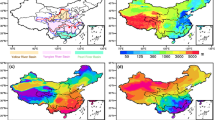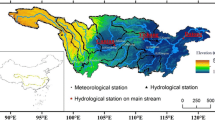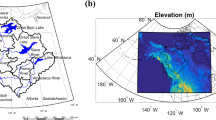Abstract
In order to explore the characteristics of climate change in the future in the West Liao River Basin under the background of future climate change, this study analyzed the changes of the annual average temperature, annual precipitation, and annual evapotranspiration from 2021 to 2060 in the West Liao River Basin under the scenarios of RCP4.5 (low emission) and RCP8.5 (high emission) originated from Intergovernmental Panel on Climate Change’s Fifth Assessment Report. The results show that (1) under the two different scenarios (RCP4.5 and RCP8.5), the annual average temperature in the West Liao River Basin is 7.67 °C and 8.12 °C, respectively, and the temperature shows an upward trend; the mutation years of RCP4.5 are more than those of RCP8.5; the annual average temperature of RCP4.5 is controlled by periods of 22 years and 29 years, while RCP8.5 has only one main period of 29 years; the contribution rates of the first eigenvector variance of EOF are 97.12% and 96.64%, respectively, and the change types are the same. The sensitive areas of variation are in the southwest and western regions respectively. (2) The annual precipitation in the West Liao River Basin under the two scenarios are 815.78mm and 798.64mm, with tendency rates of −20.51/mm/10a and 17.26/mm/10a; the mutation years in the West Liao River Basin under scenario RCP4.5 are mostly occurred in the 2030s and 2040s, while those under scenario RCP8.5 are mostly occurred in 2040s and 2050s; under scenario RCP4.5, the change is mainly controlled by shorter periods, while under scenario RCP8.5, the change is controlled by two main longer periods of 19 years and 28 years. Under the two scenarios of RCP4.5 and RCP8.5, the cumulative contribution rates of the variance of the first three eigenvectors of the EOF in the West Liao River Basin are 42% and 90.23% respectively. The first eigenvector is consistent, and the second and third eigenvectors are the reverse type of South (East)-North (West). (3) The results show that the annual evapotranspiration in the West Liao River Basin under the scenarios of RCP4.5 and RCP8.5 is 597.79mm and 618.45mm, respectively, and the trend rates are 18.20/mm/10a and 4.48/mm/10a; under scenario RCP4.5, the change is controlled by periods of 23 years and 29 years, while under scenarios RCP8.5, the change is controlled by periods of 18 years and 28 years; the contribution rates of the first eigenvector variance of EOF are 91.05% and 89.51% respectively, and they are consistent distribution, and their sensitive areas are in the southeast and central regions respectively.





Similar content being viewed by others
References
Chu Z, Guo JP (2018) Effects of climate change on maize varieties distribution in the future of Northeast China. Journal of Applied Meteorological Science 029(002):165–176. https://doi.org/10.11898/1001-7313.20180204 (in China, CSSCI)
Chu GQ, Sun Q, Wang XH, Liu M, Lin Y, Xie M, Shang W, Liu J (2012) Seasonal temperature variability during the past 1600 years recorded in historical documents and varved lake sediment profiles from northeastern China. The Holocene 22(7):785–792. https://doi.org/10.1177/0959683611430413
Chu Z, Guo JP, Zhao JF (2017) Impacts of projected climate change on agricultural climate resources in Northeast China. Acta GeographicaSinica 72(07):1248–1260. https://doi.org/10.1007/s11442-017-1420-6 (in China, CSSCI)
Ding YH (1997) Major scientific achievements and problems of IPCC second assessment report on climate change. Adv Earth Science (02):49–54 (in China, CSSCI)
Gao ZD (2015) Study of spatial temporal evolution rule and influential factors of vegetation coverage in West Liao River Basin. Shenyang Agricultural University (in China, CSSCI)
Hu XM (2013) The spatial and temporal distribution of abrupt change and trend of surface temperature in asia nearly five decades. Ocean University Of China (in China, CSSCI)
Hu T, Sun Y, Zhang XB (2017) Temperature and precipitation projection at 1.5 and 2°C increase in global mean temperature. Chin Sci Bull 62(26):3098–3111 (in China, CSSCI)
Huang JP, Chen W, Wen ZP, Zhang G, Li Z, Zuo Z, Zhao Q (2019) Review of Chinese atmospheric science research over the past 70 years: climate and climate change. Science China(Earth Sciences) 62(10):1514–1550. https://doi.org/10.1007/s11430-019-9483-5
Huang HL, Zhong GW, Dp Y et al (2020) Predicting the impact of future climate change on the distribution patterns of Toonaciliata var. pubescens in China. Journal of Nanjing Forestry University(Natural Sciences Edition) 44(03):163–170. https://doi.org/10.3969/j.issn.1000-2006.201812037 (in China, CSSCI)
Jiang DB, Fu YH (2012) Climate change over China with a 2°C global warming. Chin J Atmos Sci 36(02):234–246. https://doi.org/10.3878/j.issn.1006-9895.2011.11074 (in China, CSSCI)
Liu YS, Liu Y, Guo LY (2010) Impact of climatic change on agricultural production and response strategies in China. Chin J Eco-Agric 18(04):905–910. https://doi.org/10.3724/SP.J.1011.2010.00905
Lu WX, Liu BJ, Chen JF et al (2014) Variation trend of precipitation in the pearl river basin in recent 50 years. Journal of Natural resources 29(01):80–90. https://doi.org/10.11849/zrzyxb.2014.01.008 (in China, CSSCI)
Ma SQ, Wang Q, Luo XL (2008) Effect of climate change on maize (Zea mays) growth and yield based on stage sowing. Acta Ecol Sin (05):253–261 (in China, CSSCI)
Qin DH (2014) Climate change science and sustainable development. Prog Geogr 33(07):874–883. https://doi.org/10.11820/dlkxjz.2014.07.002 (in China, CSSCI)
Qin DH, Luo Y (2008) Causes and future trends of global climate change. Impact of Science on Society (02): 16-21. (in China, CSSCI)
Qin DH, Thomas S (2014) Highlights of the IPCC working group І fifth assessment report. Climate Change Research 10(01):1–6. https://doi.org/10.3969/j.issn.1673-1719.2014.01.001 (in China, CSSCI)
Ren YL, Wang JS, Shi YJ et al (2013) The verification of simulation ability of NCAR CAM3 global climate model in arid Central Asia. Journal of Arid Meteorology 31(02):231–239. https://doi.org/10.11755/j.issn.1006-7639(2013)-02-0231
Ren ZC, Zhu ZH, Shi H et al (2020) Spatio-temporal distribution pattern of potential natural vegetation and its response to climate change from Last Interglacial to future 2070s in China. Journal of Natural Resources (06):1484–1498. https://doi.org/10.31497/zrzyxb.20200619 (in China, CSSCI)
Su B, Gao XJ, Xiao CD (2019) Interpretation of IPCC SR1.5 on cryosphere change and its impacts. Climate Change Reach 15(04):395–404. https://doi.org/10.12006/j.issn.1673-1719.2019.139 (in China, CSSCI)
Tang G-P, Xiu BLI, Fischer G et al (2000) Climate change and its impacts on China’s agriculture. Acta Geograph Sin 55(2):129–138 (in China, CSSCI)
Wang ZC, Chen SH, Li C (2020) Analysis of the climatic change characteristics in the xiliao river basin in recent 57 years. Journal of InnerMongolia Agricultural University(Natural Science Edition) 41(01):42–48. https://doi.org/10.16853/j.cnki.1009-3575.2020.01.008 (in China, CSSCI)
Wu MH (2015) Study on wetland evolution characteristics and driving factor in West Liao River Basin. Jilin University (in China, CSSCI)
Wu SH, Luo Y, Wang H et al (2016) Climate change impacts and adaptation in China: current situation and future prospect. Chin Sci Bull 61(10):1042–1054. https://doi.org/10.1360/N972015-01240 (in China, CSSCI)
Xia F, Zhang YZ, Wu W (2009) Progress in applications of the EOF analysis in the research of coastal geomorphology and sedimentology. Prog Geogr 28(02):174–186 (in China, CSSCI)
Yang YD (2005) Monsoon climate and weather disasters in Yunnan during the Qing Dynasty (1711-1911). Fudan Univeristy (in China, CSSCI)
Yao TD, Massondelmotte V, Gao J et al (2013) A review of climatic controls on δ18O in precipitation over the Tibetan Plateau: observations and simulations. Rev Geophys 51(4):525–548. https://doi.org/10.1002/rog.20023
Zhao ZC, Wang SW, Luo Y (2007) Assessments and projections of temperature rising since the establishment of IPCC. Adv Clim Chang Res (03):183–184 (in China, CSSCI)
Zhao JF, Guo JP, Ma YP et al (2010) Change trends of China agricultural thermal resources under climate change and related adaptation countermeasures. Chin J Appl Ecol 21(11):2922–2930. https://doi.org/10.13287/j.1001-9332.2010.0406 (in China, CSSCI)
Zhao HY, Tian BX, Gong LJ et al (2017) Climate-induced potential productivity of forest vegetation during the past 308 years in northern Da Hinggan Mountain region. Acta Ecol Sin 37(06):1900–1911. https://doi.org/10.5846/stxb201510312200 (in China, CSSCI)
Zheng JY, Hao ZX, Di XC (2002) A study on establishment and application of environmental change database during historical times. Geogr Res 21(002):146–154 (in China, CSSCI)
Zhou XY, Zhao CY, Zhang XX et al (2013) Climate change characteristics and abrupt change analysis for Liaoning province, 1961-2009. Journal of Arid Land Resources and Environment 27(10):87–93. https://doi.org/10.13448/j.cnki.jalre.2013.10.027
Zhu KZ (1973) A preliminary study on climate change in China nearly five thousand years. Science in China (02): 168-189(in China, CSSCI)
Zhu HF, Zheng YH, Shao XM, Liu XH, Xu Y, Liang EY (2008) Millennial temperature reconstruction based on tree-ring widths of Qilian juniper from Wulan, Qinghai Province, China. Chin Sci Bull 53(24):3914–3920. https://doi.org/10.1007/s11434-008-0400-8
Availability of data and materials
The data is available on request from corresponding author.
Funding
This research is funded by the National Natural Science Foundation of China (41665007) and the Heilongjiang Meteorological Bureau (HQ2020020).
Author information
Authors and Affiliations
Contributions
Huiying Zhao: writing; Zhichun Wang: analysis; Xiufen Li: analysis; Zheng Chu: supervision; Chunliang Zhao: analysis; Fang Zhao: analysis.
Corresponding author
Ethics declarations
Ethical approval
N/A
Consent to participate
N/A
Consent to publish
N/A
Competing interests
The authors declare no competing interests.
Additional information
Responsible Editor: Philippe Garrigues
Publisher’s note
Springer Nature remains neutral with regard to jurisdictional claims in published maps and institutional affiliations.
Rights and permissions
About this article
Cite this article
Zhao, H., Wang, Z., Li, X. et al. Research on the evolution characteristics of future climate change in West Liao River Basin. Environ Sci Pollut Res 29, 509–517 (2022). https://doi.org/10.1007/s11356-021-15640-5
Received:
Accepted:
Published:
Issue Date:
DOI: https://doi.org/10.1007/s11356-021-15640-5




